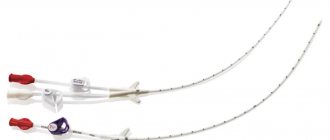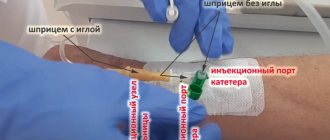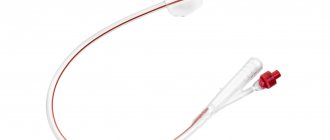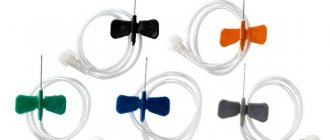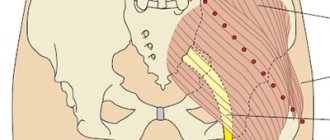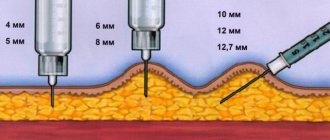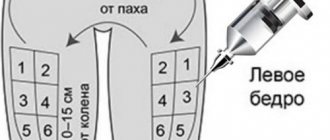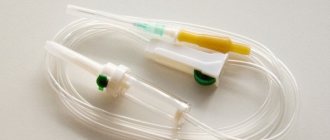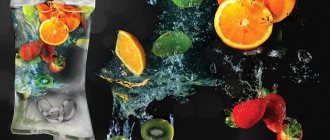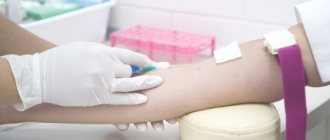Vascular catheters
Central and peripheral venous and arterial cannulas are known under this name. They are used for the following purposes: to administer drugs through the bloodstream; for blood collection. These devices are hollow, thin tubes pointed at one side that are inserted into a blood vessel in the arm, neck, or head area. On the other hand, a system with medications is connected to them. This is done to avoid frequent puncture of the veins, which leads to inflammation and blood clots. The following types of catheters exist:
- central peripheral intravenous, which is injected into the vessels of the arms;
- tunnel for large vessels, for example, the vena cava;
- subcutaneous venous, which are inserted under the skin in the chest area.
Intravenous catheter with additional port “Polyflon”, “OneFlon” or “SoftCathe”
Intravenous catheters are intended for catheterization of peripheral veins for the purpose of long-term or short-term infusion-transfusion therapy. Material: polypropylene, medical steel, Teflon, polyacetal, high-density polyethylene, low-density polyethylene, silicone.
Intravenous catheter Polyflon or SoftCathe transparent intravenous catheter made of Teflon, central hole with atraumatic edges; four x-ray positive strips along the entire length of the catheter; pavilion with a luer-lock port for connecting an infusion line or syringe; bending wings. An additional port for instant injections with a non-return petal valve is located at the top of the catheter; Equipped with a standard Luer-lock connector.
Unified color coding of the catheter size “SoftCathe”
| Catheter size, (G) | Catheter outer diameter, mm (OD) | Int. catheter diameter, mm (ID) | Color code | Length, mm | Flow rate, ml/min |
| 14G | 2,0 | 1,7 | orange | 45 | 305 |
| 16G | 1,7 | 1,3 | grey | 45 | 200 |
| 17G | 1,5 | 1,1 | white | 45 | 142 |
| 18G | 1,3 | 0,9 | green | 45 | 95 |
| 20G | 1,1 | 0,8 | pink | 32 | 65 |
| 22G | 0,9 | 0,6 | blue | 25 | 36 |
| 24G | 0,7 | 0,5 | yellow | 19 | 23 |
Stiletto needle with a triangular oblique cut; transparent needle pavilion with a Luer-lock connector, equipped with two grooves for fixing the stylet with the catheter pavilion, finger rest; removable translucent plug on the Luer-lock connector.
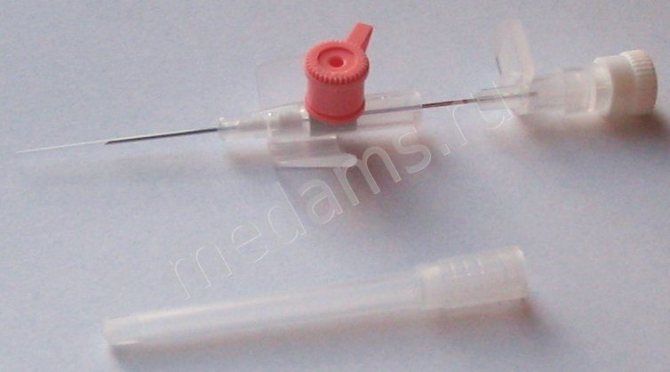
, India (i.e. “SoftCathe” or “OneFlon”) “La-med Healthcare Pvt. Ltd" , India (TM "La-med IV cannula") "SURU International PVT.LTD" , India (TM "SURUFLON") "Poly Medicure Limited" , India (TM "POLYFLON FEP" ") "Interpharma" , India (t.m. "EUROFLON")
Intravenous catheter (peripheral) with additional port of the river G16-22, price: 8.95 rub. Intravenous catheter (peripheral) with additional port of the river G 24, price: 9.95 rub. Intravenous catheter (peripheral) with additional port of the river G14 and G26, price: 11.15 rub.
Intravenous catheter with additional INTEGRAL port
An intravenous catheter with an additional port is intended for long-term (up to 3 days) administration of drugs without additional puncture into the patient’s peripheral veins. Made of fluorinated ethylene propylene (fluoropolymer) with Teflon coating, it is elastic, optimal rigidity prevents the formation of creases, transparent, non-toxic, has a high degree of biocompatibility, has pyrogen-free, non-toxic, and since it comes into direct contact with blood - biocompatible and hypoallergenic properties.
The sharp and elastic needle is made of high-quality durable medical steel and is resistant to various chemicals. Slippery surface due to the low surface tension of the polymer, optimal rigidity prevents the formation of creases.
Advantages:
- the possibility of without a needle bolus (intermittent) administration of drugs without interrupting the intravenous infusion.
- transparent chamber allows you to verify the success of venipuncture
- low coefficient of friction reduces pain during catheter insertion
- the catheter fits tightly around the needle and minimally injures tissue when inserted into a vein
- the minimum distance from the end of the catheter to the needle cut and a decrease in the thickness of the catheter wall towards the distal end facilitates vein puncture
- the presence of radiopaque stripes provides effective control over their location in the vein.
- The presence of wings allows not only to securely fix the catheter to the skin, but also reduces the risk of bacterial contamination, since they do not allow direct contact between the back of the catheter plug and the skin.
- The injection port cover opens and closes effortlessly.
- the plug has an internal thread, which ensures a tight fit of the plug to the catheter and completely eliminates contact with the patient’s blood
- The color coding corresponds to the catheter size designation.
- sterile
- intended for single use
- shelf life – 5 years
Intravenous catheter with additional port INTEGRAL dimensions
| Catheter size, (G) | Catheter outer diameter, mm (OD) | Color code | Length, mm | Flow rate, ml/min |
| 14G | 2,1 | orange | 45 | 270 |
| 16G | 1,7 | grey | 45 | 180 |
| 17G | 1,4 | white | 45 | 125 |
| 18G | 1,3 | green | 45 | 80 |
| 20G | 1,1 | pink | 33 | 54 |
| 22G | 0,9 | blue | 25 | 33 |
| 24G | 0,7 | yellow | 19 | 20 |
| 26G | 0,6 | violet | 19 | 13 |
, China (tm. "INTEGRAL")
Intravenous catheter (peripheral) with additional port of the river G 16-24, price: 8.00 rub. (remains) Intravenous catheter (peripheral) with additional. port of the river G 14 and 26 price: 10.00 rub. (leftovers)
INTRAVENOUS CATHETERS “Beromed” FOR PERIPHERAL VEINS with an additional port and fixing wings (remains)
Intravenous catheters “BEROMED” for peripheral veins with an additional port and fixing wings are used for long-term intravenous infusions. Specifications:
- The puncture needle is made of high-quality, thinnest surgical steel, which allows it to maintain strength with minimal wall thickness
- triple sharpening of the needle ensures atraumatic insertion
- the elastic surface of the catheter allows painless insertion of the catheter into the vein
- two built-in radiopaque strips
- integrated injection port "Luer" / "Luer-Lock" type "male" with non-return valve
- fixing wings allow you to securely secure the catheter
- color coding of the additional port plug allows you to visually determine the size of the catheter
- hydrophobic catheter plug prevents blood leakage, removable plug for quick closure of the catheter
- catheter material FEP (fluoroethylpropylene), sizes G 14, 16, 17, 18, 20, 22, 24, 26
- the entire product is made of materials with a high degree of biotolerance, sterile, pyrogen-free, non-toxic
- Individual packaging, easy to open, contains all the necessary information about the product.
Intravenous catheter with additional port Beromed dimensions
| Catheter size, (G), length, (inch) | Catheter outer diameter x length, mm | Color code | Flow rate, ml/min FEP | Flow rate, ml/min PUR |
| 14G – 1 3/4 | 2.1 x 45 mm | orange | 305 | 305 |
| 16G – 1 3/4 | 1.7 x 45 mm | grey | 200 | 200 |
| 17G – 1 3/4 | 1.5 x 45 mm | white | 142 | 142 |
| 18G – 1 3/4 | 1.3 x 45 mm | green | 95 | 95 |
| 20G – 1 1/4 | 1.1 x 32 mm | pink | 60 | 60 |
| 22G – 1” | 0.9 x 25 mm | blue | 36 | 36 |
| 24G – 3/4 | 0.7 x 19 mm | yellow | 23 | 23 |
| 26G – 3/4 | 0.62 x 19 mm | violet | 17 | 17 |
, Germany (t.m. “BEROCAN”) Venous catheter with additional port + wings, river. G 16-24, price: 12.00 rub. Venous catheter with additional port + wings, r. G 14-26, price: 14.00 rub.
Peripheral venous catheter with a protective clip and an additional port with POLY SAFETY wings, FEP material (Teflon)
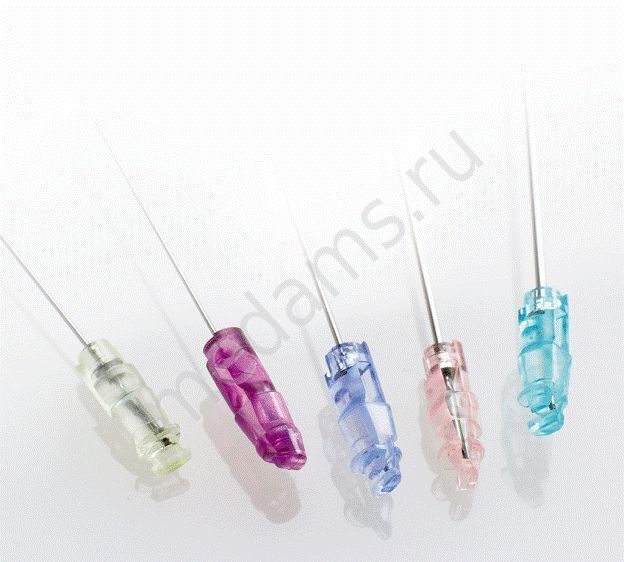
The peripheral intravenous catheter, equipped with a self-locking device (Safety type) is a disposable sterile peripheral intravenous catheter on a sterile stainless steel needle, intended for puncture and catheterization of peripheral veins, equipped with a device for blocking the needle tip in the form of a bullet-shaped clip that is self-installed during reverse traction (when removed needles from the catheter).
disposable venous catheter - has a device (hydrophobic plug) that blocks the needle tip with a plastic clip during the completion of the traction movement when removing the needle from

Safety catheter composition: Manufacturing materials: FEP (Teflon) or PUR (Polyurethane) , the catheter has 4 (FEP) and 6 (PUR) fully built-in radiopaque strips, an additional infusion port with a tight, quick-release, harness-fixed, sealed cap, wings , Luer-Lock plug, puncture needle is made of stainless steel with an additional Luer-Lock plug made of opaque white plastic with a faceted outer surface, fixed on the needle pavilion plug. International color coding for catheter cap. Does not contain Latex (LATEX FREE) Safety FEP (G) catheter sizes: 14, 16, 18, 20, 22, 24, 26, 27 Packaging: Individual, sterile, Tyvek blister, multiples of 100 pcs. Sterilization: ethylene oxide. Shelf life: 5 years. Brand and , India
Price:
Intravenous catheter with protective device “POLYSAFETY” material FEP (Teflon) p. G 16-22, price: 45.00 rub. Intravenous catheter with protective device “POLYSAFETY” material FEP (Teflon) p. G 24, price: 47.00 rub. Intravenous catheter with protective device “POLYSAFETY” material FEP (Teflon) p. G 26, price: 50.00 rub.
Types of cavity catheters by area of application
There are many different types of abdominal catheters.
For the nasal and oral cavities, aspiration catheters with a Kapkon or Vakon port are used. They can also be used to suction the trachea and bronchi. Epidural anesthesia is performed using epidural catheters. If it is not possible to excrete urine naturally, which necessitates long-term drainage of the bladder, Malekot catheters are used. They remove urine through an external fistula on the anterior abdominal wall. However, Foley and Nelaton catheters are most often used in medical practice.
Placement and care of an intravenous catheter
Central vein catheterization is performed using one of three techniques: using a catheter on a needle, similar to the installation of a peripheral catheter, passing the catheter through a needle of a larger diameter, and also using the Seldinger method (through a self-destructive guidewire).
The insertion of an intravenous catheter or port system is performed under aseptic conditions by experienced medical personnel. Local anesthesia or general anesthesia is used. Unlike a port system, an intravenous catheter can become a conduit for infection to enter the body. To avoid this, you should strictly follow the rules for using and caring for the catheter as prescribed by your doctor.
Foley catheters
These products are primarily used in the treatment of diseases of the genitourinary system in men and women for the following procedures:
- urine excretion;
- administering medications;
- organ washing;
- drainage of organs.
Visually, this device looks like a tube, at one end of which there are two or three branches, and at the other end a balloon is attached to hold the product in the bladder. The catheter can be used for a long time. In a two-way modification, one channel is used to drain urine, the second is used to fill the balloon. The three-way one has an additional channel for administering drugs. There are options for women (shorter) and for children (smaller diameter). The products are made from latex coated with silicone and sold in sterile packaging.
Nelaton catheters
This type of product is used for short-term drainage of the bladder and urethra; their main difference from the devices described above is the absence of a balloon.
The design is quite simple: the main part is a hollow tube with a semicircular tip at one end and a urine collection connector at the other. Male versions may have a slightly curved Tiemann tip, which greatly facilitates their insertion. Catheterization in men is more difficult, so it is important that the device can be guided without injury.
The devices vary in size, with the longest ones being for men. The size is determined using a special Charrière scale; for clarity, the connectors are marked with a certain color. The products are made from polyvinyl chloride or polyurethane; they feel quite hard to the touch, but when exposed to body heat they become softer. Due to the lack of fixing elements, their long-term use is not intended. More expensive models are coated with a lubricant to facilitate insertion or an antibacterial layer.
Peripheral venous catheter Vogt Medical, Germany (VM)
The VM peripheral venous catheter is used for catheterization of peripheral veins in patients requiring long-term infusion therapy. They are designed for catheterization of peripheral veins for the purpose of long-term infusion therapy; a special catheter profile, as well as triangular sharpening of the guide needle, provide optimal conditions for puncture of the vessel. The cannula is made of thermoplastic and biocompatible material, which is ideal for long-term catheterization, and the radiopacity of the cannula material allows you to control its position. The wings provide comfortable grip during manipulation and reliable fixation of the cannula, thereby eliminating the possibility of accidental removal. Reverse blood flow chamber
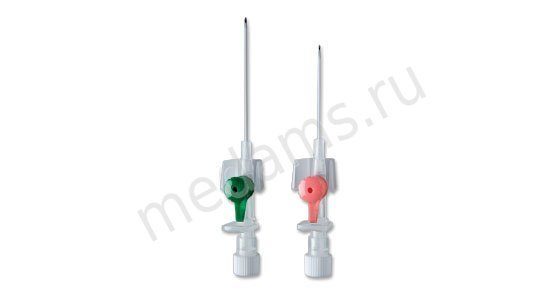
| Catheter size, (G), length, (inch) | Catheter outer diameter x length, mm | Color code | Flow rate, ml/min |
| 14G – 1 3/4 | 2.1 x 45 mm | orange | 270 |
| 16G – 1 3/4 | 1.8 x 45 mm | grey | 200 |
| 17G – 1 3/4 | 1.5 x 45 mm | white | 140 |
| 18G – 1 3/4 | 1.3 x 45 mm | green | 85 |
| 20G – 1 1/4 | 1.1 x 32 mm | pink | 55 |
| 22G – 1” | 0.9 x 25 mm | blue | 33 |
| 24G – 3/4 | 0.7 x 19 mm | yellow | 18 |
| 26G – 3/4 | 0.6 x 19 mm | violet | 10 |
Intravenous catheter (peripheral) with additional port of the river G17-22 price: 9.60 rub. Intravenous catheter (peripheral) with additional port of the river G14, 16 and G24 price: 10.90 rub. Intravenous catheter (peripheral) with additional port of the river G26 price: 11.90 rub. , Germany Analogs: Vasofix Braunula / Intravenous cannulas with injection port “Vasofix”
PEDIATRIC CANNULES WITH SMALL WINGS AND INSERTION DEVICE for newborns and small children
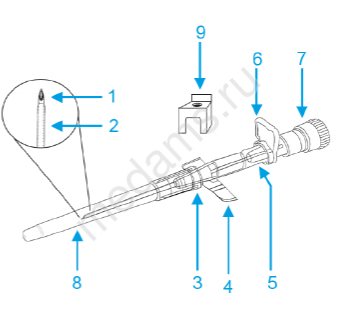
Needle (Stainless steel)- Cannula (Fluoroethylenepropylene/polyurethane)
- Cannula holder (Polyoxymethylene)
- Wing body (Polypropylene)
- Needle hub (Polypropylene)
- Needle gripper (Polypropylene)
- Luer Lock Cover (High Density Polyethylene)
- Needle cover (Polypropylene)
- Device for inserting a catheter into a vein (Polypropylene).
Intended use: Catheterization of peripheral veins in newborns and small children is an effective method of providing reliable access to the venous system for catheterization of thin and fragile vessels and is recommended for use in neonatology, pediatrics and geriatrics, Removable false port system (device for inserting a catheter into a vein) makes it possible to use the usual gripping technique when inserting a catheter. After installing the catheter, flexible wings are released, facilitating reliable fixation even on the arm of a newborn. The use of peripheral venous cannulas (IV cannulas) in neonatology and pediatrics significantly reduces the number of complications and improves the quality of treatment, ensures motor activity and comfort for the child and minimizes the psychological burden on relatives. Main advantages: The pediatric venous catheter (IV cannula) has a special convenient design for use in neonatology and pediatrics:
•Available in sizes (24 - 26 G) •Best needle tip geometry with Buck Cut cut (special sharpening) •Cannulas with built-in 4 radiopaque strips •Made from PU (polyurethane) or FEP (fluoroethylenepropylene) •PU cannulas have “ “memory effect” •Thromboresistant catheter •High biocompatibility •Latex-free
| Catalog no. | X-ray contrast stripes | Size | Length in mm | Wings | Flow rate | Code color | Quantity per pack |
| IV PEDIATRIC CANNULES WITH SMALL WINGS AND INTRODUCTION DEVICE | |||||||
| 1311702H | 4 | 24G | 19 | small | 18 ml/min | yellow | 100/1000 |
| 1311703H | 4 | 26G | 19 | small | 10 ml/min | violet | 100/1000 |
Quality and safety: Standard: ISO 10555-1.5 Sterilization: Ethylene Oxide Shelf life: 5 years. Packaging: Blister packaging / 100 pcs per pack. 1000 pcs. in cor. , Germany Price: 20.00 rub. Analogues: " BD Neoflon", B.Braun "Vasofix"
Fixation of catheters
Catheters should always be secured to the body or organ.
They can be attached to the skin with adhesive tape, suture material or special fasteners. Some cavity non-vascular catheters have a special design that allows them to be fixed in the organ independently: an inflatable balloon, a loop system, Malecot, Petzer systems, etc. Today, the Pigtail system is becoming increasingly common: during installation, the tip of the catheter is straightened and is located in a special guide. When the guidewire is removed, the tip curls like a pig's tail and prevents the device from falling out. The modern medical product market offers a large selection of catheters for various purposes. There are more expensive models, with an improved design, and there are basic ones, simpler, but no less effective. The current range of these products is presented in the Deznet LLC store at affordable prices.

